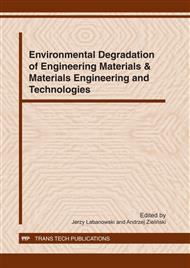p.1
p.9
p.17
p.25
p.31
p.37
p.43
p.49
Electrochemical Deposition of the Ca-P Coatings on the Porous Nanocrystalline Ti-6Al-4V Alloy
Abstract:
The formation mechanism of the Ca–P coating on the porous nanocrystalline Ti-6Al-4V alloy is presented. The Ca–P compounds were cathodically deposited at different potential (from –0.5 to –10 V vs. open circuit potential), using a solution mixture of Ca (NO3)2 + (NH4)2HPO4 + HCl. Depending of the deposition potential, the atomic ratio of Ca/P in deposits is in the range from 0.25 to 1.71, which indicates that the coating composition corresponds in some cases to hydroxyapatite. The Ca–P particles penetrate preferentially the pores inside, which improve bonding of the bioceramic layer to the metallic substrate. Increasing the cathodic deposition potential results in changes of the Ca–P morphology from thin porous, through cracked up to thick 90 μm continous coating. The porosity of the Ca–P decreases with increasing cathodic deposition potential. It is proposed the electric field enhancement mechanism of the electrolytic ions flow and Ca–P growth on the surface irregularities, such as pores and surrounding hillocks.
Info:
Periodical:
Pages:
1-8
Citation:
Online since:
December 2011
Authors:
Keywords:
Price:
Сopyright:
© 2012 Trans Tech Publications Ltd. All Rights Reserved
Share:
Citation:


